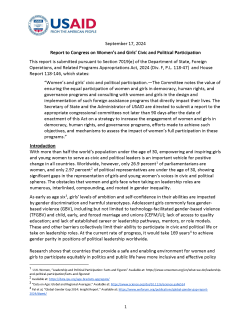This report is submitted pursuant to Section 7019(e) of the Department of State, Foreign Operations, and Related Programs Appropriations Act, 2024 (Div. F, P.L. 118-47) and House Report 118-146, which states:
“Women’s and girls’ civic and political participation.—The Committee notes the value of ensuring the equal participation of women and girls in democracy, human rights, and governance programs and consulting with women and girls in the design and implementation of such foreign assistance programs that directly impact their lives. The Secretary of State and the Administrator of USAID are directed to submit a report to the appropriate congressional committees not later than 90 days after the date of enactment of this Act on a strategy to increase the engagement of women and girls in democracy, human rights, and governance programs, efforts made to achieve such objectives, and mechanisms to assess the impact of women’s full participation in these programs.”
Introduction
With more than half the world’s population under the age of 30, empowering and inspiring girls and young women to serve as civic and political leaders is an important vehicle for positive change in all countries. Worldwide, however, only 26.9 percent1 of parliamentarians are women, and only 2.97 percent2 of political representatives are under the age of 30, showing significant gaps in the representation of girls and young women’s voices in civic and political spheres. The obstacles that women and girls face when taking on leadership roles are numerous, interlinked, compounding, and rooted in gender inequality.
As early as age six3, girls’ levels of ambition and self-confidence in their abilities are impacted by gender discrimination and harmful stereotypes. Adolescent girls commonly face gender-based violence (GBV), including but not limited to technology-facilitated gender-based violence (TFGBV) and child, early, and forced marriage and unions (CEFM/U); lack of access to quality education; and lack of established career or leadership pathways, mentors, or role models. These and other barriers collectively limit their ability to participate in civic and political life or take on leadership roles. At the current rate of progress, it would take 169 years4 to achieve gender parity in positions of political leadership worldwide.
1 U.N. Women, “Leadership and Political Participation: Facts and Figures” Available at: https://www.unwomen.org/en/what-we-do/leadership-and-political-particip…
2 Available at: https://data.ipu.org/age-brackets-aggregate/
3 “Data on Age: Global and Regional Averages.” Available at: https://www.science.org/doi/10.1126/science.aah6524
4 Pal et al, “Global Gender Gap 2024: Insight Report.” Available at: https://www.weforum.org/publications/global-gender-gap-report-2024/dige…

